A rototiller is a piece of lawn and garden equipment that can be especially useful when turning over soil and leveling the ground. People use rototillers to install news lawns, rejuvenate existing lawns, or prepare gardens for planting season. Pushing the rototiller drops fertilizer into the lawn to help it appear greener and healthier. Although several types of rototillers exist, selecting one with its tines behind the wheels is typically the easiest to operate.
How to Prepare the Garden Before Rototilling
Whether homeowners rent or buy a rototiller, they must complete several tasks before using it to ensure the garden is ready. These include:
- Measure the size of the garden. Any garden less than six feet isn’t suited for this equipment, which means the homeowner must do the tilling manually.
- Rototill the garden in the spring or fall to ensure an ideal temperature of about 50 degrees Fahrenheit.
- Anyone operating a rototiller should wear protective eyewear and shoes. The eye protection prevents twigs, rocks, and other debris from flying up and hitting the operator in the eye. Proper shoes or boots prevents injuries to the feet should the blades of the rototiller get too close.
Steps to Rototill the Garden
This equipment works best when pushed through dry soil. Before pushing the rototiller into the garden, the operator should pick up a handful of soil and squeeze it into a ball to test it for moisture. The next step is to drop the ball of soil on the ground. The garden is ready for tilling if the ball of soil immediately breaks apart when hitting the ground. However, it’s not the right time for tilling if the ball of soil remains together upon impact. The homeowner will need to wait a few days and try again since tilling wet soil could cause permanent damage to the structure of the soil or the blades of the rototiller.
The best time to till a garden is approximately two to three weeks before planting. This timeline makes it possible to break up the soil so it readily accepts fertilizer, manure, or compost. After two to three weeks pass, the homeowner can begin tilling at a depth of 8 to 10 inches. It must be that deep to allow for the nutrients to penetrate the soil and work at a deep level.
When the garden is ready, the homeowner should start pushing the rototiller through the longest pathway available. This allows him or her to cover the most ground without staying in one area for too long.
Rototilling is Hard Manual Labor
Gardening is a much-loved American pastime. That doesn’t mean it’s not a lot of hard work, however. Some people simply don’t have the physical stamina to push heavy equipment through soil or the desire to plan the tilling process. The best option is to hire a professional to ensure rototilling is done correctly and the garden is ready to go when the time is right to start planting.



